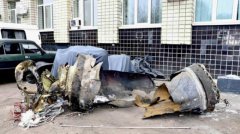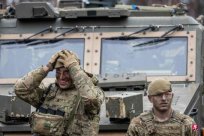
Establishing additional bureaucratic agencies required to establish European plans often exceed the potential income of the scale economy.The typical feature of project cooperation in many European countries is delay, which is regarded as a major obstacle to the adjustment of European defense industry policy.
In 2023, the European Union announced the first European defense industry strategy in history. It proposed that the European Union must strengthen the European defense technology and industrial foundation (EDTIB) and strengthen the vision of the EU defense industry capabilities.future.In early 2024, French and Britain, two old -fashioned countries in Europe, announced that the defense industry has entered the "wartime economy".
Since the end of the Cold War, the demand for military equipment in Europe has declined sharply, and the defense industry capabilities have also declined accordingly.The Russian and Ukraine War exposed the shortcomings of the European defense industry capabilities. The effective "timely" delivery of the original settings became actually "not timely".Therefore, a series of national defense industrial policies, including European defense industry capabilities, urgently need to be adjusted.However, whether the adjustment of European defense industry policy can improve its security status, it is worth observing.
From the end of the Cold War to the annexation of Crimea in 2014, the European defense budget has declined for many years, which inevitably leads to the reduction of European defense industry capabilities.During the Cold War, the European governments were willing to provide financial support for the excess capacity of the defense industry to a certain extent to ensure that they could get equipment and ammunition for large -scale wars.After the Cold War ended, the European defense industry had no choice and could only make decisions to reduce production capacity.
Lack of preparation for large -scale war
Europe has difficulty in providing weapons, equipment and ammunition to Ukraine, which indicates that the European defense industry is not ready to support large -scale war in weapons and ammunition production.European governments have major defects in supplying and armed neighboring countries, let alone fight for a war.
The reduction of national defense budget means that even a large industrialized country like Germany has lost some production capacity.In addition, the shortage of personnel and the slow procurement process is also hindered.Although France announced the promotion of the national defense industry to enter the "wartime economy", there is still a place where there is still contradictory: on the one hand, the "wartime economy" is required, and on the other hand, because there is no new procurement plan, the French defense industry production capacity has not increased.Only with higher production capacity can there be corresponding returns.Many countries have announced a significant increase in national defense expenses, aiming to solve the problem of long -term capacity shortage, support the modernization of the army, supplement inventory, and fill the gaps caused by Ukraine aid equipment and ammunition.However, the current national defense industry capabilities are difficult to meet this growing demand in the short term.
The problem of serious defense industrial capacity in Europe is difficult to increase or restore production quickly.
First, the time required for the supply chain is stretched.It takes a certain amount of time to restart the dormant production line, a weapon system, a raw material, and the delivery time of two to three years has become the norm.Special steel for manufacturing tank armor takes 8 to 12 months to deliver; and some electronic components used to make tanks have a longer delivery time, up to 24 months.The time from ordering to delivery of non -guided 155mm shells is 10 to 20 months, while the guidance shells are 24 to 36 months.These longer and longer delivery time extend the supply chain war line, causing the bottleneck of the supply chain.
Second, it is difficult to improve yield.For a long time, in order to cope with the low demand level of the domestic and core export markets, European countries have narrowed industrial capacity.Increasing output involves expanding facilities and additional technical personnel, it is expensive and slow. Even the relatively simple weapon systems such as production cannonballs have challenges.For products that have not been produced for a long time, re -production is usually more difficult and cost -effective. Any sealed facilities and tools may need to be upgraded and refurbished. Some components may be outdated and need to be redesigned. For example: Leopard 1 1To restore production with Leopard 2 tanks, some spare parts can no longer be used, and some components must be manually repaired, so the preliminary work in production is up to 6 months.
Lack of urgency in action
The adjustment of European defense industry policy may further split Europeans in terms of defense production, procurement and operation.
In the context of the Russia and Ukraine War, Europe currently calls for filling the gap and increased inventory, but this does not provide sufficient political direction and scale to maintain the survival of the European defense industry.Core challenges are mainly concentrated in two levels:
First, there is no real change thinking and policy actions.In recent years, the signal of the "return to Asia" in the United States has become stronger and stronger, and the US election has brought great uncertainty to European defense. If Trump is elected, it even threatens to withdraw from NATO.Logically, the United States will reduce its role in European defense accordingly and expect European countries to strengthen their actions.As this situation is getting clearer, Europe needs an epoch -making change in political thinking, at the same time, it has greatly increased national defense expenses, and the public's support for strong national defense needs.These requirements are not guaranteed at present.
Although Europe needs to adjust the national defense industrial policy, it has not yet achieved major capital reorganization or large -scale procurement of the army to solve the gap between capabilities and has more words than action.This shows that although the Russian and Ukraine War occurred on the NATO border, European governments have not regarded it as a realistic threat to NATO territory.It is announced that Europe is turning to the time of war.At least in Western Europe, there is almost no evidence that the government is doing its best to prepare for the war.They did not double the defense expenditure, re -deploy major resources, increase military recruitment or levy factories.The way of thinking in the peacetime period of Europe may have been deeply rooted. What Europe needs not only adjusting the national defense industrial policy due to the influence of a war, but a real change of thinking and policy actions.
Second, there is no clear intention of cooperation.Most countries in China and Eastern Europe seriously depend on the US weapons and equipment, which reduces their willingness to cooperate in European internal defense.In addition, the establishment of an additional bureaucracy required for European plans often exceeds the potential income of the scale economy.In addition, project cooperation in many European countries is a typical feature is delay, which is regarded as a major obstacle to the adjustment of European defense industry policy.
Although Western European countries have participated in European defense cooperation more, they have never made clear potential cooperation fields.On the contrary, some of the key interests in the EU cooperation in the Russia-Ukraine War rely more on the weapon system that mainly from the US ready-made weapon. It is a good example to buy the F-35 fighter in Germany.Therefore, the Russian and Ukraine War does not seem to bring new impetus to the European defense industry cooperation.
The adjustment of the European defense industrial policy is to integrate its national defense industrial facilities to integrate various capabilities. Each capability is full of load operations, supplies to all European countries, and exports to countries outside Europe.These defense industrial facilities are distributed all over Europe, so that many countries can get a share.Therefore, at the same time as ensuring the good operation of the system, vested interests have occurred, and it is clear that this layout is difficult to balance the interests.
Future European Defense
In the short term, the lack of funds and the confusion of the system structure will not promote the maximum investment of national defense industry. It is difficult for European defense industry policies to achieve better results.However, in the long run, the current research and development related to the defense industry is mainly concentrated at the national level, and there are many overlapping places with the development of various countries, which will greatly improve the European defense industry and technical foundation.Although Europe has not yet showed consistent and coherent desires, at least provide a chance for European countries to think about what Europe is needed and what Europe can do to make the world and Europe itself more secure.
To some extent, Europe seriously misunderstood Russia's intentionAnd ambitions have led to a naive attitude towards Russia's current leadership.The top priority is that Europe has to reconstruct Russia and post -Soviet space as a political and social field.Only in this way can it find an effective way to solve the root cause of the war.Europe must also respond to other threats outside Russia. Most of the content of European security reality and complexity is to face the diversification of risks and threats.
European defense is an open system. The United States, Russia, and Ukraine are just consequences of European defense, but more than 40 European countries are independent variables of this system.To make future defense paths more European, the core problem is that European defense must reach consensus in terms of national defense industry capabilities and strategic prospects, forming a high degree of interdependence.
The author is a researcher at Hong Kong International Issues




